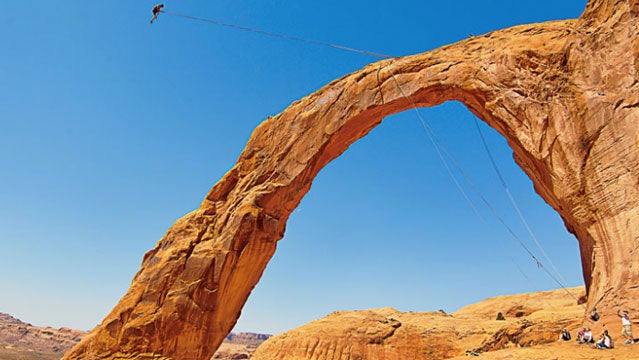Thad James claims to be one of the first people to swing from Utah’s Corona Arch, a 140-foot sandstone bridge on public land near Moab. James, the owner of local outfitter , says it all started in 2011 when he was rappelling from the arch one day with a friend, Brock Howell. “On our way down,” James says, “He asked if it was possible to jump and swing through the opening, and I said it would be if we had the right angle.”
A couple months later, Howell and a group of friends were swinging through the arch, launching from its flank using existing rappelling bolts. In mid-February 2012, Howell’s crew was filmed at the swing by YouTube phenom Devin Graham, whose made the rope swing look like the most fun you could have. It quickly went viral, clocking nearly 20 million views as of today.
As the video spread around the internet, rope-swingers came. In droves. “Anytime I put out a video that has a product in it,” says Graham, “They sell like crazy. I imagine it’s the same for any places that I shoot. There’s no question that it impacts people. When you get 10, 15, or 20 million views, it says a lot about how much traffic will go to that place.”
By June, James had secured a permit from the agency with jurisdiction over the arch, the (SITLA). The permit allowed him to take paying clients out for a swing. Six months later, around 120 Utah High �����ԹϺ��� customers had strapped on a harness and flown through the arch with the greatest of ease (and perhaps a good bit of terror).
“Before the YouTube video came out it was hardly ever touched,” James says of the arch. “You would see maybe one person rappelling each week.” But after the video hit, James says he would get up at 4 a.m. and start hiking to the arch and start setting up the gear at 5 or 6 a.m., and then wait for clients to arrive. If he didn’t, private groups would beat him to the arch and set up a swing.
While Graham’s video made Corona Arch a viral media star, it appears that Howell and his buddies were not the first to set up a rope swing—not by a long stretch. Bryan Torgerson, resource specialist for SITLA, says it’s been going on for decades, just not in the sort of numbers that anyone would notice. “People have been swinging through the arch for as long as they’ve been rappelling off it,” says Torgerson. “Since the seventies.”
Last year, as more outfitters recognized the opportunity, permit applications multiplied and SITLA started to worry about the safety implications. Someone, it was quite obvious, could be seriously injured, or killed. In late December, the agency decided to revoke Utah High �����ԹϺ���’s permit for commercial rope swinging at Corona Arch and preclude others from attaining permits.
This left the arch open only to private citizens, such as 22-year-old Kyle Lee Stocking from West Jordan. On March 24, Stocking died from injuries sustained after slamming into the base of the arch during a swing. The rope he was using had too much slack.
THE RISKS INHERENT to swinging on a massive, makeshift pendulum are obvious, but can be controlled through thorough planning and testing (such as measuring the rope by tossing a rock-filled bag through the swing). The lesser risks are equipment failure or, perhaps, slipping off the launch before being harnessed. Most jumpers thread the portion of the ropes that rub against the rock through a section of fire hose or garden hose, to protect the rope from fraying.
But what of the harms done to the arch itself? There are already grooves that have been dug into the arch over decades of rappelling (and, apparently, swinging), though Torgerson says that the grooves are “minimal.” Schuman and James agree, the grooves are there but they’re not massive.
While it could be confused with the Delicate Arch or similar landforms that are in Arches National Park or other parts of the National Park System, Corona Arch is on multi-use land that is open to far more recreational uses than the National Park Service allows. Under SITLA authority, Corona Arch has very few limitations on allowable use.
In the short term, wear and tear on the arch isn’t a huge concern, since the area is unlikely to see the rope-swing frenzy of 2012. Stocking’s death will presumably quell enthusiasm among other would-be swingers, and the absence of commercial operators has likely already narrowed the field. However, the arch is part of a land swap that is underway between SITLA and the Bureau of Land Management (BLM). Once that happens, the rules may change.
James says that he plans to apply for a permit to restart his rope-swing business. If he gets it, other operators will likely come knocking.
“We’re still assessing the situation regarding whether we would allow a rope-swing permit again on Corona Arch,” says Aaron Curtis, outdoor recreation chief in the BLM’s Utah State Office. “The main thing is, applicants will go through standard permit application that will include an environmental analysis. Is this a sustainable use? Would it impact the land? Will it harm public safety? And what is the demand?”
The BLM must, by mandate, maintain lands for multiple uses, and while leases sold to energy developers and ranchers represent most of its income, it does earn a 3-percent cut of gross revenues through the recreation permits it issues. It knows that the spectrum of adventure sports is always evolving. In fact in Utah, the BLM earns more revenue from recreational leases than grazing leases. High-lining and slack-lining, for example, are gaining devotees.
The land swap includes not just Corona Arch but a total of 47,000 acres of environmentally-sensitive land along the Colorado River corridor. The Utah State BLM could face recreational permit requests in many of these areas. Tourists already shell out for guided mountain biking, off-roading, climbing, and —perhaps lured by increasingly prolific POV adventure videos—why not rope-swinging or high-lining as well?
As for Corona Arch, even if the BLM decides not to issue permits to rope-swing operators, people will continue to swing there (. But Curtis doesn’t believe rope-swings will appreciably harm the arch—or at least, not in his lifetime. If environmental impacts or safety issues become significant, he says, the BLM has the authority to ban rope-swinging (or any other activity) and restrict access to popular sites.
Curtis knows of no sport that the BLM has outright banned on its Utah lands, but the risk profile of adventure sports on public lands is certainly on the rise. According to the , 2012 was a record year for the Grand County Search and Rescue team, at 108 missions. Among those accidents was a “spate” of B.A.S.E. jumps that went awry. None of these six missions resulted in a fatality, and Mario Richard, co-owner of with Steph Davis, says none of them were related to his commercial outings. “We have a 100% safety record,” he says.
Richard noted that sometimes a passerby will call Search and Rescue (SAR) after seeing a jumper who is hung up in a tree or otherwise stuck, but not injured. “They might be doing a self-rescue,” he says, “Or maybe they have a friend on the way to help, but once 911 is called, search and rescue has to come.”
Still, Moab sees a million visitors a year and its reputation as a B.A.S.E., climbing, and adrenaline-sports Mecca is likely to grow. The number of mountain bikers involved in rescue missions grew steadily from 2001 to 2010, as did the number of drivers of off-road vehicles. Climbers and rappelers requiring rescue remained low during that time, and most years saw just one or two injured B.A.S.E. jumpers.
Beyond safety and environmental impacts, there’s the question of whether adrenaline sports detract from the wilderness experience. While the footprint of adventure sports pales in comparison to that of, say, a natural gas well, it’s not benign. Sometimes, bolts are drilled. Usually, people leave more than footprints. Always, people scream.
“High-adrenaline activities are loud and rambunctious,” Curtis says. “Sometimes people come to the backcountry just for the peace and quiet.”


